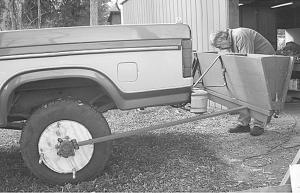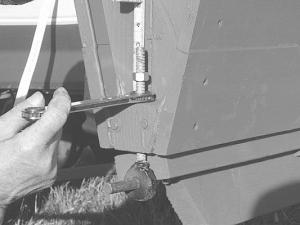Low-Cost Lime Spreader Ideal For Small Jobs
Custom lime applicators often don't want to bother with small jobs. Barb and Bob Lee decided to spread lime themselves on their small fields and paddocks. Rather than buy a unit, they found plans on the internet and built a low cost, homemade spreader.
"We're trying to breed Blackbelly Barbados sheep for organic meat sales, and healthy sheep require healthy pasture," says Barb Lee. "We're trying to rejuvenate our worn-out soil by getting the calcium levels up."
The Lees quickly discovered that not only was custom application expensive, no one would even consider doing their six acres. When they found plans for a spreader at www.bright.net/~fwo/Lime.html, they decided to build a 10-ft. version that fits the back of their pickup. Best of all, it works with powdered lime, which the Lees found is half the price of granulated lime preferred for hand spreading.
The design is simple with an equally simple spreading action. It consists of 18-in. sides (length is optional) with a series of dividers inside that make multiple compartments to maintain an even distribution of material.
A 2 by 4-in. shaker board mounted to the bottom of the lime box can be adjusted to flex open and shut, holding the lime in place or releasing it. In spread mode, it's kept in constant motion striking the bottom of the box and flexing open to release lime.
A tension spring centered on and mounted to the rear side of the box and the shaker board provides the flex. Eye bolts extend through the shaker board and through small wood blocks attached to the ends and the center divider. Tightening or loosening the nut on the eyebolts allows more or less lime to be released as the board flexes. Short lengths of steel rod attached to the 2 by 4 and extending through the eye of the bolts, keeps them from turning.
A knocker arm is attached to one end of the front side of the shaker board. It extends alongside a rear wheel of the Lee's pickup to a knocker disk with the length determined by the distance from wheel to box. The knocker disk is a round piece of plywood with four 6-in. long, 1/2-in. steel pins mounted equidistant around its perimeter.
The disk is cut to fit the wheel with holes for lug bolts, hub and valve stem. A second set of lug nuts secures it in place, while four steel pins extend out and away from the wheel.
As the wheel rotates, the knocker arm lifts, flexing the shaker board open against the tension spring. As the knocker arm is released from one pin, it strikes the next pin, "shaking" the lime down and out.
Calibrating the lime spreader is relatively easy. The first step is to place a known amount of lime in the spreader. The plans suggest 300 lbs. Adjust the nuts on the eye bolt uniformly and drive at a set speed until the spreader is empty. Measure the distance driven in feet and multiply by the width of the spreader. To get acres spread, divide the total by 43,560 (square feet in one acre) to get the percent of an acre covered by 300 lbs. at that setting. Then adjust the nuts accordingly. Different settings (perhaps 500-lb. increments) can be marked on the center divider and ends for quick adjustment in the future. Increasing or decreasing the speed can also alter the spread rate.
"It's crude, but it works great, letting us spread about a ton per acre on our small fields," says Barb. "Now we're planning a 4-ft. box to get into even smaller paddocks."
Contact: FARM SHOW Followup, Barb Lee, 18555 S. Lyons Rd., Oregon City, Oregon 97405 (ph 503 631-2862; info@ black locustfarm.net; www.blacklocustfarm.net).

Click here to download page story appeared in.
Click here to read entire issue
Low-Cost Lime Spreader Ideal For Small Jobs FERTILIZER APPLICATION Fertilizer Application (58f) 32-2-29 Custom lime applicators often don't want to bother with small jobs. Barb and Bob Lee decided to spread lime themselves on their small fields and paddocks. Rather than buy a unit, they found plans on the internet and built a low cost, homemade spreader.
"We're trying to breed Blackbelly Barbados sheep for organic meat sales, and healthy sheep require healthy pasture," says Barb Lee. "We're trying to rejuvenate our worn-out soil by getting the calcium levels up."
The Lees quickly discovered that not only was custom application expensive, no one would even consider doing their six acres. When they found plans for a spreader at www.bright.net/~fwo/Lime.html, they decided to build a 10-ft. version that fits the back of their pickup. Best of all, it works with powdered lime, which the Lees found is half the price of granulated lime preferred for hand spreading.
The design is simple with an equally simple spreading action. It consists of 18-in. sides (length is optional) with a series of dividers inside that make multiple compartments to maintain an even distribution of material.
A 2 by 4-in. shaker board mounted to the bottom of the lime box can be adjusted to flex open and shut, holding the lime in place or releasing it. In spread mode, it's kept in constant motion striking the bottom of the box and flexing open to release lime.
A tension spring centered on and mounted to the rear side of the box and the shaker board provides the flex. Eye bolts extend through the shaker board and through small wood blocks attached to the ends and the center divider. Tightening or loosening the nut on the eyebolts allows more or less lime to be released as the board flexes. Short lengths of steel rod attached to the 2 by 4 and extending through the eye of the bolts, keeps them from turning.
A knocker arm is attached to one end of the front side of the shaker board. It extends alongside a rear wheel of the Lee's pickup to a knocker disk with the length determined by the distance from wheel to box. The knocker disk is a round piece of plywood with four 6-in. long, 1/2-in. steel pins mounted equidistant around its perimeter.
The disk is cut to fit the wheel with holes for lug bolts, hub and valve stem. A second set of lug nuts secures it in place, while four steel pins extend out and away from the wheel.
As the wheel rotates, the knocker arm lifts, flexing the shaker board open against the tension spring. As the knocker arm is released from one pin, it strikes the next pin, "shaking" the lime down and out.
Calibrating the lime spreader is relatively easy. The first step is to place a known amount of lime in the spreader. The plans suggest 300 lbs. Adjust the nuts on the eye bolt uniformly and drive at a set speed until the spreader is empty. Measure the distance driven in feet and multiply by the width of the spreader. To get acres spread, divide the total by 43,560 (square feet in one acre) to get the percent of an acre covered by 300 lbs. at that setting. Then adjust the nuts accordingly. Different settings (perhaps 500-lb. increments) can be marked on the center divider and ends for quick adjustment in the future. Increasing or decreasing the speed can also alter the spread rate.
"It's crude, but it works great, letting us spread about a ton per acre on our small fields," says Barb. "Now we're planning a 4-ft. box to get into even smaller paddocks."
Contact: FARM SHOW Followup, Barb Lee, 18555 S. Lyons Rd., Oregon City, Oregon 97405 (ph 503 631-2862; info@ black locustfarm.net; www.blacklocustfarm.net).
To read the rest of this story, download this issue below or click
here to register with your account number.








